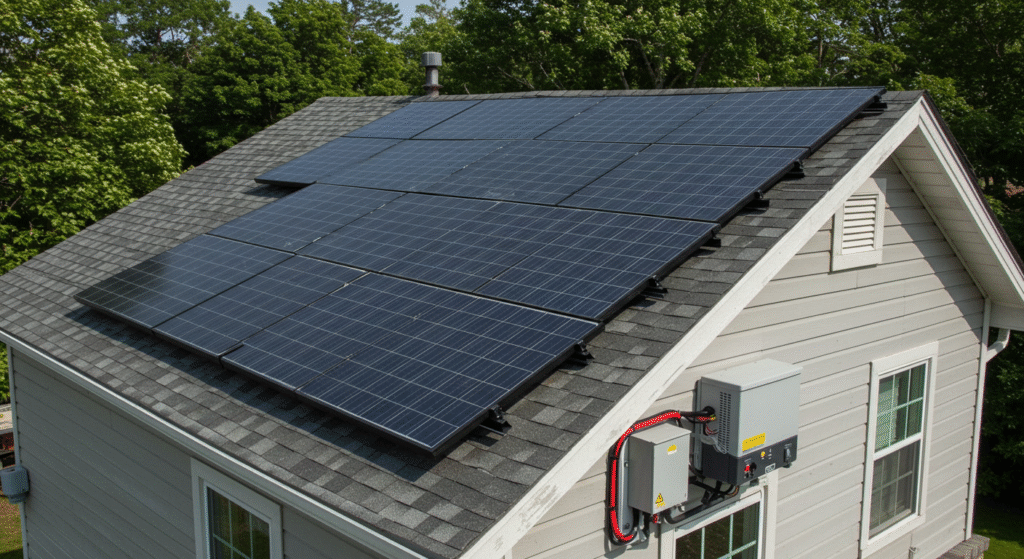Mini Home Solar Power Systems
By admin

In 2025, the push for renewable energy has never been stronger. Homeowners, renters, and rural residents alike are seeking sustainable ways to power their lives while reducing dependence on unreliable grids. Mini home solar power systems offer a compact, affordable solution, delivering clean energy for essentials like lighting, phone charging, and small appliances. These systems are a game-changer for eco-conscious consumers, DIY enthusiasts, and those preparing for emergencies or living off-grid.
At Power Solutions, LLC, we specialize in reliable mini solar solutions that cater to diverse needs—from urban backups to rural electrification. This guide dives into what makes these systems tick, their benefits, and how to pick the right one for your home. Let’s explore why mini solar is the future of affordable, renewable energy.
What is a Mini Home Solar Power System?
A mini home solar power system is a small-scale setup, typically under 1 kilowatt (kW), designed for basic household energy needs. Unlike full-size systems (3–10 kW) that power entire homes or portable kits for camping, mini systems strike a balance—perfect for lighting a room, charging devices, or running a fan or radio. Often called home solar kits or small solar systems for houses, they’re ideal for off-grid living or as a backup during outages.
For example, a 100-watt system can produce 400–600 watt-hours daily, enough to power 3–4 LED lights for 6–8 hours and charge multiple phones. Their simplicity and affordability make them a hit in rural areas with no grid access and urban homes needing reliable power alternatives.
Key Components of a Mini Solar Home System
A mini solar system’s efficiency hinges on its core components. Here’s what you’ll find inside:
- Solar Panels: These capture sunlight and convert it into electricity. Monocrystalline panels, with ~20% efficiency, are common in mini systems due to their compact size and performance.
- Battery Storage: Stores daytime energy for nighttime use. Lithium-ion batteries (up to 10-year lifespan) outperform lead-acid (3–5 years) in durability and cold-weather efficiency.
- Charge Controller: Regulates energy flow to prevent battery overcharging. A PWM controller (10–20 amps) suits most small systems.
- Inverter (Optional): Converts DC to AC for appliances like TVs. A 300-watt inverter is typical for mini kits.
- Wiring Options: Plug-and-play systems are beginner-friendly, while custom-wired setups offer flexibility for tech-savvy users.
To visualize this, imagine sunlight hitting a solar panel, energy flowing to a battery via a charge controller, and an LED glowing at night—arrows tracing each step. Learn more in our solar components guide.
Top Benefits of a Mini Solar Power System for Homes
Why go mini? Here’s what you gain:
- Energy Independence: Generate your own power and slash bills—crucial in off-grid or outage-prone areas.
- Reliability: Perfect for rural homes or unstable grids, ensuring lights stay on when you need them.
- Ease of Use: Install in hours, maintain with minimal effort—just clean panels and check batteries occasionally.
- Affordable Investment: Starting at $150, they pay off fast. A Kenyan family replacing kerosene with a 100-watt system saves $100 yearly, recouping costs in under two years.
Plus, they’re eco-friendly, cutting CO2 emissions by ~50 kg annually—equivalent to planting a tree.
How to Choose the Right Mini Solar System for Your Home
Picking the right system starts with your needs:
- Assess Power Needs: Calculate daily usage—e.g., 50 watt-hours per light, 20 per phone charge. A 100-watt system (500 watt-hours/day) can handle 3 lights and charging.
- Set a Budget: Basic kits cost $150; premium ones with lithium batteries hit $500–$700. Higher upfront costs often mean better longevity.
- Install Safely: Face panels south (Northern Hemisphere) for max sunlight. Secure with brackets and follow wiring guides—see our installation guide.
- Consider Location: Sunny areas need less capacity; cloudy ones may require bigger batteries.
Best Use Cases and Examples
Mini solar shines in these scenarios:
- Urban Backup: A 200-watt system powers lights and devices during city outages.
- Rural Living: A Cambodian family uses a 50-watt kit for lighting and phones, enhancing daily life.
- Emergency Kits: A 100-watt system supports lights and radios during disasters.
- Community Use: A 400-watt system powers a school’s lights or a clinic’s fridge.
In 2024, Power Solutions, LLC teamed with the UN to deploy 1,000 systems in African clinics, proving their real-world impact.
Why Choose Power-Solution Mini Solar Systems?
Power Solutions, LLC offers 50–720-watt kits built for reliability, using monocrystalline panels and lithium batteries. Certified by NABCEP, we’ve powered 500+ small businesses in emerging markets and partnered with the Red Cross and World Bank. A Texas customer raves: “My 200-watt cabin system runs everything I need—setup was a breeze, and support was stellar.” Check out our mini solar kits.
Frequently Asked Questions
Panels last 20–25 years; batteries 3–10 years (lithium longer).
A 400-watt system with a big battery can, but 100-watt systems are too small.
A 500 watt-hour battery runs a 10-watt light for 50 hours.
Yes, add panels or batteries as needed—check compatibility.
Conclusion
Mini home solar power systems bring renewable energy within reach, offering savings, reliability, and sustainability. Whether you’re off-grid or prepping for emergencies, they’re a smart choice. Explore our mini solar kits at Power Solutions, LLC or contact us for tailored solutions. Harness the sun today!


